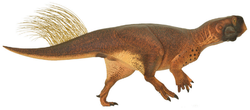| Albertaceratops Temporal range: Late Cretaceous, | |
|---|---|
 | |
| Skull in Philip J. Currie Dinosaur Museum | |
| Scientific classification | |
| Kingdom: | Animalia |
| Phylum: | Chordata |
| Class: | Reptilia |
| Clade: | Dinosauria |
| Clade: | † Ornithischia |
| Clade: | † Ceratopsia |
| Family: | † Ceratopsidae |
| Subfamily: | † Centrosaurinae |
| Clade: | † Albertaceratopsini |
| Genus: | † Albertaceratops Ryan, 2007 |
| Species: | †A. nesmoi |
| Binomial name | |
| †Albertaceratops nesmoi Ryan, 2007 | |
Albertaceratops (meaning "Alberta horned face") is a genus of centrosaurine horned dinosaur from the middle Campanian-age Upper Cretaceous Oldman Formation of Alberta, Canada. [1]







